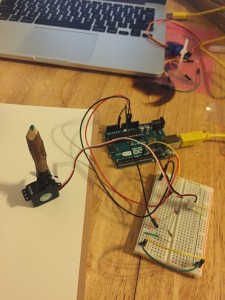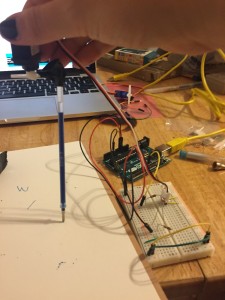PComp, Wk 4: Simple Application – Drawing Machine
INTRO
As I mentioned in my lab blog post, I was really intrigued by the possibilities of controlling an object’s motion. When I saw the arms of the servo motor rotate, I started thinking about using it to create a kind of drawing machine.
Maybe it’s because a pencil is my favorite tool, but I thought it would be interesting to look at how analog input can translate into a digital context, then be re-written as a different kind of analog output. I like playing with the idea of creating some complicated digital process to do something we could easily do as analog (this has come up a lot in my ICM sketches).
There’s part of me that theoretically/conceptually enjoys the idea of unnecessary over-complications re: digital applications. But I was also thinking about how this particular machine creates a product that you couldn’t replicate by hand- not exactly, at least. (Thought: I wonder if I standardized this enough if I could replicate results, with human interaction being the one variable?)
I used to teach photography to elementary and middle school kids and one of the first things we always did was break down what the work photography means – photo LIGHT and graph DRAW – in Greek. So I thought it would be funny to do a different kind of “light drawing” – using information from the light sensor to power a servo motor that has attached drawing implements.
PROCESS
While I was already familiar with using a photosensor to control a servo motor from the lab this week, at first I encountered some issues that I hadn’t come across before. My servo made a definite hissing sound when I first hooked it up. I tried it out with the second one I just bought and the same thing happened. So, I snooped around the internet and found this page. Looks like it has something to do with the upload. I re-uploaded the sketch and didn’t have anymore weird hissing issues!
Once that was solved, I went about trying to figure out how to attach a drawing tool to the servo motor and what kind of drawing tool to use.
I first tried out a pencil, but I couldn’t get enough pressure to make a mark. Then I thought, what if I found an easy flowing ink pen/marker…maybe one I could take the ink cartridge out of, so it would be thin enough to tape to the arms?
Well…I remembered I had a butt-load of gel pens (because I’m still a 10 year old girl).
I rigged one up, tried out a few different positions and orientations in relation to the motor and settled on the following:
Once I got that to work, I thought I’d try adding a second color and see what I got. Picked orange, bc complimentary colors, yo.
IMG_4467 from Zoe Bachman on Vimeo.
So then I thought…what about TWO SERVO MOTORS! AND FOUR COLORS!
I hooked up both servos to the same analog PMW output pin…
IMG_4473 from Zoe Bachman on Vimeo.
SUCCESS! tricky to do it with two, only because you have to hold one in each hand and have someone wave their hand over the photocell to change the direction. I put my roommate on hand-waving and video duty (hence why it’s filmed vertically…)
THINGS TO THINK ABOUT:
After I got my drawing machine to work, a few modifications came to mind. Currently, it doesn’t function in exactly the state that I want it to. That the pens don’t always produce a mark is the biggest problem. The blue and the orange worked relatively well, but I think I’d try it again with a different drawing utensil.
I’d also be curious at mapping different levels of brightness. Currently, the sensor is sort of working in a switch-ish state that if you cover it up completely or take your hand off forces the motor to turn 180 degrees. Rapidly waving your hand makes a few smaller motions, but I’d like to play around with this relationship more intentionally.
Similar to that, I’d like to see what would happen if each servo motor had it’s own light sensor controlling it’s function so that they didn’t move simultaneously.
Another thing I was thinking of playing around with was using a DC motor and playing with speed rather than position.
Lastly, if I was to develop this into more of a complete prototype…what kind of container/interface would I design for it? I like being able to hold two pens in one hand, and it would need to expand the surface area so it would be easier for the hand to grip while still allowing the motors and pens to rotate. Anyways, just some thoughts…

